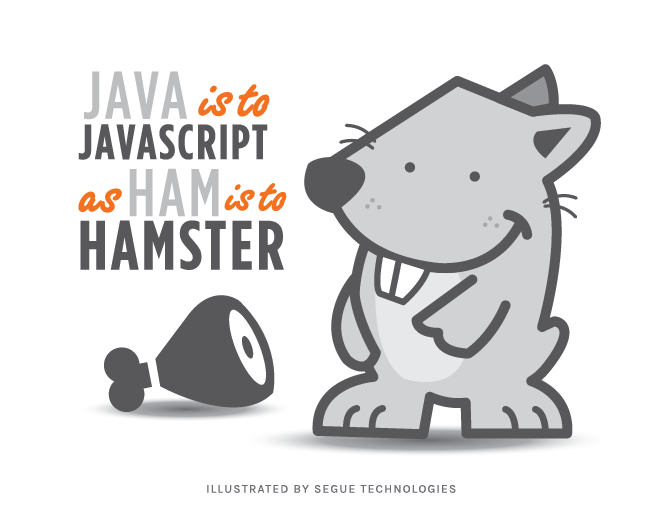Everyone assumes that because JavaScript has “Java” in its name they are somehow related. While most programmers groan at this coupling and many even feel that the name confusion is part of a marketing gimmick, the history of the two programming languages did intersect for a brief moment in time during the early days of Netscape. The evolution of the two languages took such wildly different paths from that point forward that the common joke is that Java is to JavaScript as ham is to a hamster. But if you’re reading this article, you’re probably interested in a more useful explanation, so let me compare the two.

If we traveled back in time about five years or so, this would be a simple comparison: Java is a general purpose programming language, and JavaScript is used on websites to make them animated and interactive. Now that JavaScript has “grown up,” the comparison is much more complicated. Let’s take a look at some of their similarities and differences from a web development perspective:
Both Can Run in a Browser
JavaScript runs on most modern browsers, and most websites take advantage of this to enhance the user’s experience. Java applets can also run in a browser, but they have been declining in popularity for various reasons, including compatibility and security. It is reasonable to expect a website visitor to have JavaScript enabled and it is common for a website visitor to have Java applets disabled, especially with the proliferation of mobile browsers.
Both Can Run on a Server
Java has long been a major workhorse of the web with application servers like WebSphere, JBoss, and Apache Tomcat running a large portion of the web applications seen by users on both public sites and behind corporate firewalls. While JavaScript has dabbled in the server-side realm for a while, the recent popularity of Node.js is causing more JavaScript-powered application servers to pop up all over the place.
Compiled vs. Interpreted
Java code is typically written in an Integrated Development Environment (IDE) and compiled into bytecode. This bytecode is not readable by humans and any Java Virtual Machine (JVM) should be able to run it. JavaScript code is normally executed by a JavaScript engine in the same syntax in which it is written, although JavaScript files that are sent over the internet are often compressed into a barely readable format to reduce their size. Making changes in Java application environments can require several steps using specialized software to compile and deploy the changes, while making changes to JavaScript can sometimes be done with just a simple text editor.
Both Are Influenced by the Programming Community
Java uses the Java Community Process to accept input on what to include in the language in the form of Java Specification Requests. Oracle, the current owner of Java, uses these to determine the official implementation of the language. JavaScript, on the other hand, is a derivative of ECMAScript which is defined by the European Computer Manufacturers Association (ECMA), a non-profit standards organization. Without open processes like these, programming languages have a tendency to become obsolete and more proprietary, thus creating vendor lock-in to an inferior product.
Write-once, Run-anywhere vs. Branching Madness
Java is specifically designed to enable developers to write their code once and deploy it to any operating system without making changes. In general, this does work as designed, although sometimes there are hiccups depending on the JVM and the code used. Although JavaScript has a standard through ECMAScript, it is much more susceptible to the differences in execution environments (normally in the form of different browsers). While it is very frustrating for developers to write JavaScript code for different environments, one silver lining is that the program itself can query the environment to decide what branch of code to run for that specific environment.
Two-Stage vs. Runtime-only Debugging
Java is compiled before it can be run, so if there are any structural problems with code they become apparent very quickly. Once it is running, IDEs often enable the developer to attach to the JVM to debug in real-time. JavaScript is not compiled in the same way, so all bugs are found at runtime. As such, the debugging capabilities of JavaScript are highly dependent on the execution environment and this can vary quite a bit.
Both Have Libraries and Frameworks
Libraries and frameworks help programmers by providing access to general and purpose-specific code that can be reused over and over again for different products. When used properly, libraries and frameworks can cut development time – sometimes by a very significant factor. Both Java and JavaScript are mature enough to have a wide range of library and framework options available to assist developers in a variety of scenarios.
If these Java vs. JavaScript match-ups aren’t enough for you, feel free to delve into technical, performance-related, or popularity-based comparisons.The important thing to remember, however, is that they are not the same, so be careful when looking for a technical resource and ensure they have the right experience for the right technology.